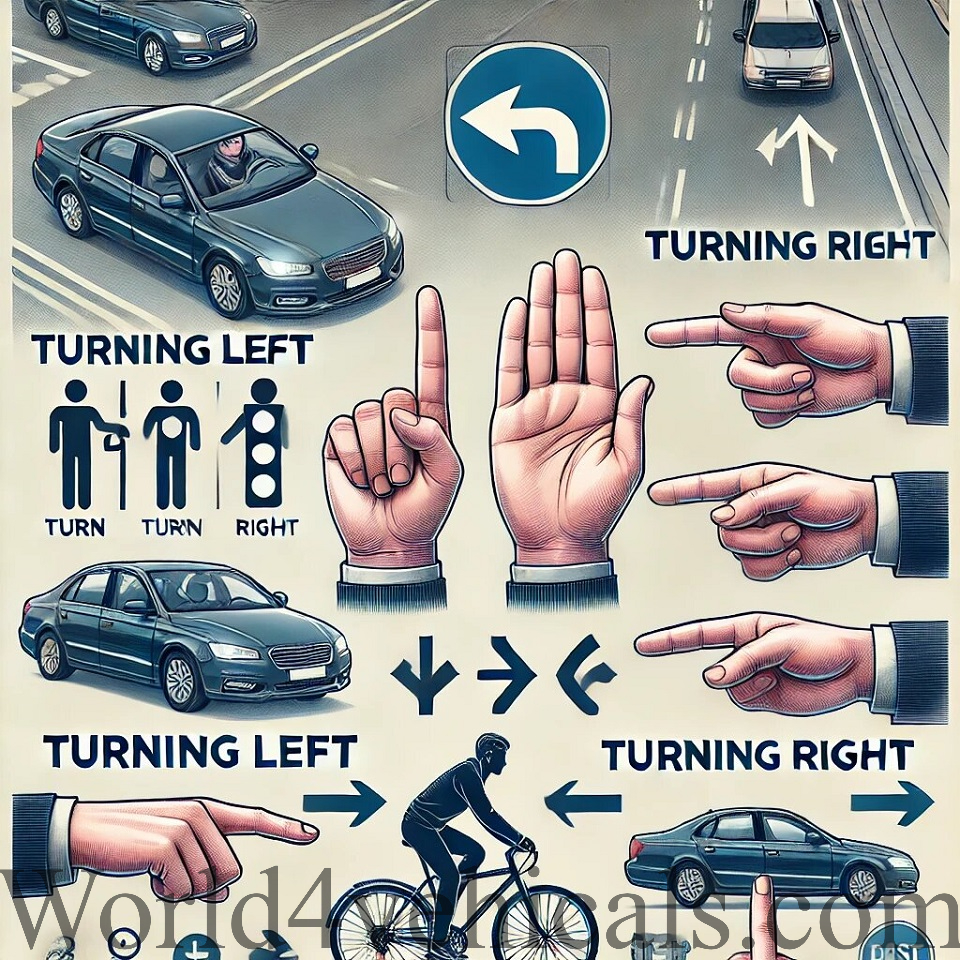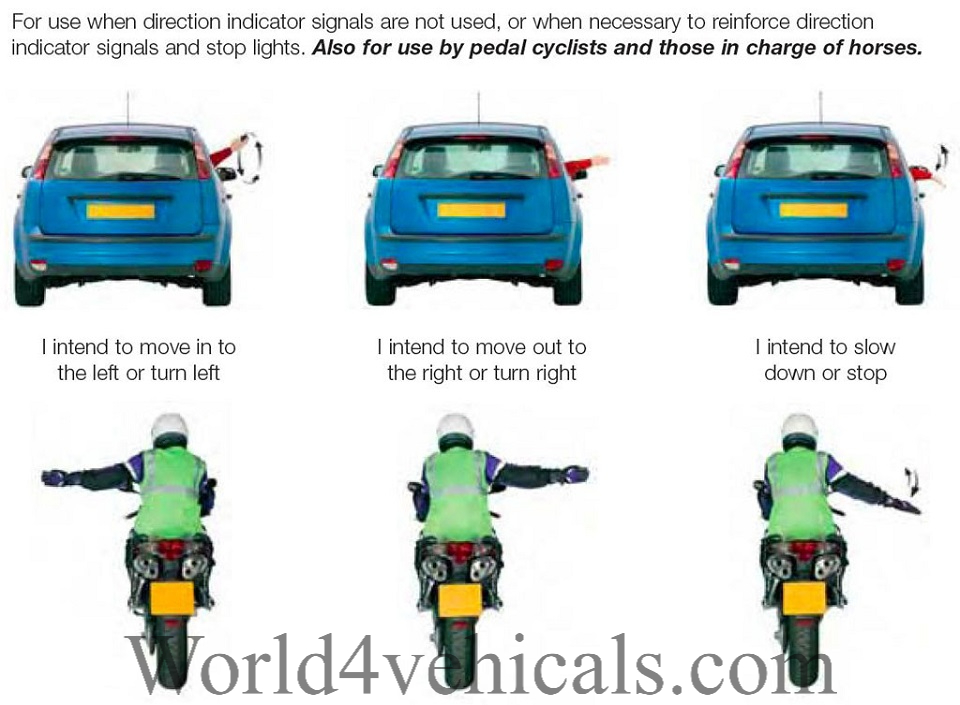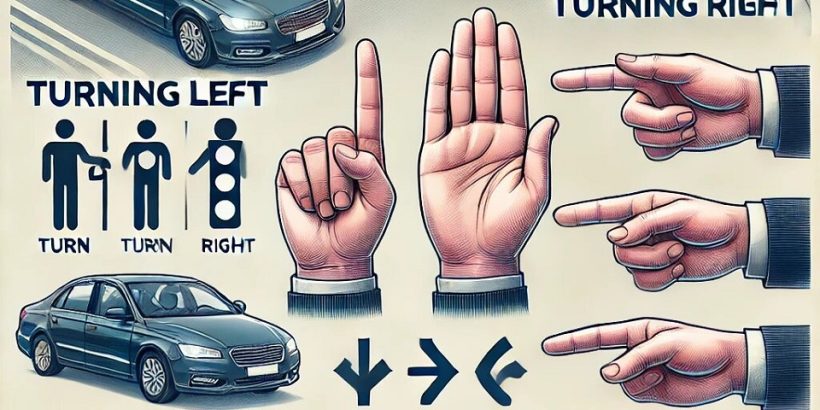Introduction
Driving Hand Signals is an essential that requires clear communication between drivers, pedestrians, and cyclists. While modern vehicles are equipped with turn signals and brake lights, there are situations where hand signals become crucial. Whether you’re a new driver, a cyclist, or someone driving an old vehicle with malfunctioning lights, understanding hand signals is vital for road safety.]

In this guide, we will explore everything about driving hand signals, including their importance, how to use them correctly, their historical significance, and when they should be applied.
What Are Driving Hand Signals?
Driving hand signals are standardized gestures used by drivers and cyclists to indicate their intentions on the road. These signals ensure smooth traffic flow and help avoid accidents. They are especially useful when:
- A vehicle’s turn signals or brake lights are not functioning.
- A driver wants to make intentions clear in heavy traffic.
- Cyclists or motorcyclists need to communicate with other road users.
- A driver is operating a vehicle that does not have built-in indicators, such as some older models or specialized machinery.
Why Are Driving Hand Signals Important?
Understanding and using hand signals correctly offers several benefits:
- Enhances Road Safety: It helps prevent accidents by clearly conveying the driver’s intent.
- Legal Compliance: In many regions, drivers must use hand signals when vehicle lights are not working.
- Useful for Cyclists & Motorcyclists: Since they lack built-in signals, hand gestures are their primary way to communicate.
- Essential for Emergency Situations: If electronic signals fail, hand signals act as a backup.
- Promotes Better Understanding Among Road Users: When used correctly, hand signals ensure clarity, reducing the chances of road rage and misinterpretation.
A Brief History of Driving Hand Signals
Before turn signals and brake lights became standard in vehicles, hand signals were the primary means of communication for drivers. The concept originated in the early 20th century when automobiles were first introduced. Military vehicles and early commercial trucks widely used hand gestures to communicate with other road users. Although turn signals and brake lights are now common, hand signals remain a crucial part of driver education and safety regulations.
Common Driving Hand Signals
There are three primary driving hand signals that every driver and cyclist should know:
1. Left Turn Signal
- How to Do It: Extend your left arm straight out of the driver’s window with your palm facing forward.
- When to Use: When you intend to turn left or change lanes to the left.
- Importance: This ensures vehicles behind you slow down and prepare for your turn.
2. Right Turn Signal
- How to Do It: Extend your left arm out of the window and bend it upward at a 90-degree angle with your palm facing forward.
- Alternative for Cyclists: Some cyclists may extend their right arm straight out instead of using the left arm bent upward.
- When to Use: When making a right turn or switching lanes to the right.
3. Stop or Slow Down Signal
- How to Do It: Extend your left arm out of the window and bend it downward at a 90-degree angle with your palm facing backward.
- When to Use: When slowing down suddenly or stopping.
- Importance: Prevents rear-end collisions by alerting other drivers of your action.
When to Use Driving Hand Signals
Hand signals should be used in specific situations, such as:
- Malfunctioning Vehicle Lights: If turn signals or brake lights fail.
- Cycling or Motorcycling: When electronic indicators are unavailable.
- Driving in Areas Without Electricity: Some rural areas have poor visibility, requiring manual signaling.
- Emergency Situations: If your car’s electrical system malfunctions unexpectedly.
- In Heavy Traffic: To ensure that your intentions are visible to other road users.
- In Off-Road or Construction Areas: Where hand signals may be a clearer form of communication among workers and drivers.
Tips for Using Hand Signals Correctly
To maximize the effectiveness of hand signals, follow these best practices:
- Use Hand Signals Well in Advance: Give other road users enough time to react.
- Ensure Visibility: Make sure your arm movements are clear and noticeable.
- Always Check Surroundings: Before turning or stopping, ensure that it is safe.
- Combine Hand Signals with Mirror Checks: Always confirm the movement of vehicles around you before making a maneuver.
- Be Consistent: Use the proper hand signals every time to build awareness and consistency among other drivers.
Legal Requirements for Hand Signals
Different countries and states have specific laws regarding hand signals. In most regions:
- Hand signals must be used when vehicle lights are not working.
- Cyclists and motorcyclists are legally required to use hand signals.
- Failing to use hand signals properly can result in fines or penalties.
To ensure compliance, check your local traffic laws regarding hand signals.
The Role of Hand Signals in Defensive Driving
Defensive driving is about anticipating potential hazards and ensuring maximum safety on the road. Hand signals contribute to defensive driving in several ways:
- Prevents Miscommunication: Ensures other drivers understand your intent.
- Reduces Accident Risks: Helps avoid confusion, especially in congested areas.
- Improves Awareness: Makes you more conscious of your surroundings.
- Enhances Communication in Low-Light Conditions: While not a replacement for proper lighting, hand signals can still help in emergencies.

Common Mistakes to Avoid When Using Hand Signals
Despite their simplicity, many drivers make mistakes while using hand signals. Here are some errors to watch out for:
- Using Hand Signals Too Late: This confuses other road users.
- Not Keeping the Hand Signal Long Enough: Hold the signal until the turn or stop is initiated.
- Using the Wrong Hand Signal: This can mislead other drivers.
- Failing to Make Eye Contact with Other Drivers: Confirm that they have seen your signal.
- Assuming Everyone Understands Your Signal: Some newer drivers may not be familiar with them, so remain cautious.
Conclusion
Driving hand signals are a fundamental part of road safety that every driver, cyclist, and motorcyclist should understand. They provide a simple yet effective way to communicate intentions, especially in situations where electronic indicators are unavailable. By mastering and applying these signals correctly, you can contribute to a safer and more organized driving environment.
Make sure to practice these signals and incorporate them into your driving habits. Safe driving starts with clear communication, and hand signals are a crucial tool to achieve that. Stay alert, stay safe, and always signal your intentions on the road!
Understanding and respecting these signals will not only enhance your driving skills but also promote safety for all road users, creating a responsible and harmonious driving culture for everyone.
